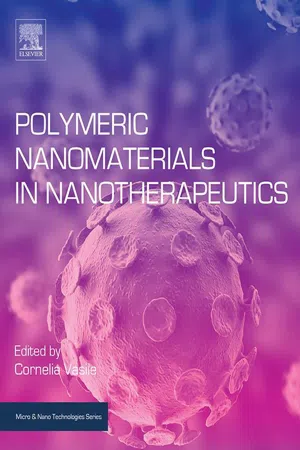1.1 Introduction
Nanomaterials: in October 2011, the European Commission (EC) recommended to define nanomaterials as “natural, incidental or manufactured material containing particles, in an unbound state or as an aggregate/agglomerate and where, for 50% or more of the particles in the number size distribution, one or more external dimensions is in the size range of 1–100 nm” and the specific surface area/volume of the material is greater than 60 m2/cm3 (EC, 2011; Kreyling et al., 2010). The Scientific Committee on Emerging and Newly Identified Health Risks (SCENIHR) proposed a limit of 0.15% of nanoparticles below 100 nm for the definition of nanomaterials (SCENIHR, 2010). Nanomaterials can be classified as zero-dimensional, one-dimensional, two-dimensional, or three-dimensional. Nanomaterials possess unique physical (ultrasmall size, large surface area to mass ratio, high surface energy, optical, electrical, magnetic, etc.), chemical (high reactivity), and biological properties, which are different from bulk materials of the same composition. By their characteristics nanomaterials are able to modify the fundamental properties of therapeutic and diagnostic agents and other materials.
Nanotechnology is defined as the science and engineering involved in the design, synthesis, characterization, and application of materials and devices whose smallest functional organization in at least one dimension is on the nanometer scale (10−9 m). That means it controls, programs, and manipulates matter on the nanometer length scale, that is, at the level of atoms, molecules, and supramolecular structures (i.e., molecular precision).
Nanotechnology applied in biotechnology is called nanobiotechnology (Torchilin, 2014).
Nanomedicine is considered as a subdiscipline within nanotechnology or nanosciences applied in medical sciences and helps in the prevention and treatment of various diseases. Diagnostic uses include for monitoring, repair, construction, and control of human biological systems at the molecular level, using engineered nanodevices and nanostructures (Sahoo et al., 2007). It combines nanotechnology with pharmaceutical and biomedical sciences. Nanomedicine goals are of developing novel therapeutic and diagnostic modalities and imaging agents with higher efficacy and improved safety and toxicological profiles. As a refinement of molecular medicine, nanomedicine integrates advances in genomics and proteomics, facilitating the development of personalized medicine (Jain, 2008; Zhang et al., 2007a).
The benefits of nanomedicine include: effective and less toxic therapeutic interventions, simplified therapeutic procedures, targeted drug delivery, accelerating the healing process, improved patient compliance and quality of patient’s life, reducing the frequency of dosage, minimally invasive method of administration, improved therapeutic outcomes, reducing adverse drug effects, personalized therapy, etc. From an economic point of view the benefits consist of an overall reduction in healthcare costs (e.g., by increasing the drug efficacy, reducing the duration of in-patient care stay, reducing personal healthcare costs, and the effective treatment of expensive major diseases), improving the quality of healthcare services, improved use of costly (bio)pharmaceuticals (e.g., low-dose formulation, improved drug solubility/stability, controlled drug release, improved pharmacokinetic profile, targeted drug delivery).
The integration of diagnostics with therapeutics facilitates the development of personalized medicine, that is, prescription of specific therapeutics best suited for an individual. Nanomedicine uses biomaterials, such as hard tissue implants, bone substitute materials, dental restoratives, soft tissue implants, and antimicrobial materials, drug carriers, etc. (Huber et al., 2009; Wagner et al., 2006c).
The number of academic papers using the term “nanomedicine” has increased exponentially since 2000 (Web of Science) from only a few to over a thousand. The use of nanoparticles (NPs) addresses two of the most important health challenges facing society: cancer treatment and the need for new antimicrobials.
Nanomedicines are defined as nanomaterials for specific diagnostic or therapeutic purposes (Kostarelos, 2006), as therapeutic or imaging agents. Nanomedicines control the in vivo biodistribution, improve targeting, enhance the efficacy, and reduce toxicity of a drug or biologic. It is known that the physiological and pathological processes at the cell level occur on a nanoscale. Nanoscale devices can readily interact with biomolecules (such as enzymes and receptors) on both the surface of the cell and inside the cell. Nanoscale devices are 100–10,000 times smaller than human cells. Therefore, nanoparticles can detect disease at the microlevel, provide detailed information on the progression of disease, and deliver treatment.
The terms nanopharmaceuticals and nanotherapeutics have been introduced, while colloidal systems are redefined as nanosystems, and colloidal drug-delivery systems are called nanodrug-delivery systems.
Nanotherapeutics, including polymeric ones, refers to the use of nanomedicines in areas of drug delivery and therapy conferring additional and unique properties to the drug (Hafner et al., 2014) with regard to bioavailability enhancement (Fakes et al., 2009; Lammers et al., 2012), reduced acute/systemic toxicity (Ando et al., 2011; Rom et al., 2013), or improved therapeutic efficiency by targeting compounds to a specific site of action (Low et al., 2011; Martinez et al., 2014). NPs have improved the bioavailability of drugs compared to their free form, such as cyclosporine (119% of free form) (Italia et al., 2007), estradiol (1014%) (Mittal et al., 2007), doxorubicin (DOX) (363%) (Grama et al., 2011), amphotericin B (793%) (Grama et al., 2011), curcumin (2583%) (Grama et al., 2011), (2200%) (Tsai et al., 2011), (1560%) (Khalil et al., 2013), and lutein (Chen et al., 2016). Nanotherapeutics tools are used to improve drug solubility/diffusivity of poorly water-soluble drugs (including micelles (Pepic et al., 2010) and nanocrystals (Junghanns and Müller, 2008)) to guide drugs to the desired location of action with increased precision (drug targeting (Crielaard et al., 2012;Zhang et al., 2012a)), to control drug release (nanoparticles (Hafner et al., 2009, 2011; Vasile et al., 2015a,b) and liposomes (Pavelic et al., 2005), and/or to enhance transport acro...
